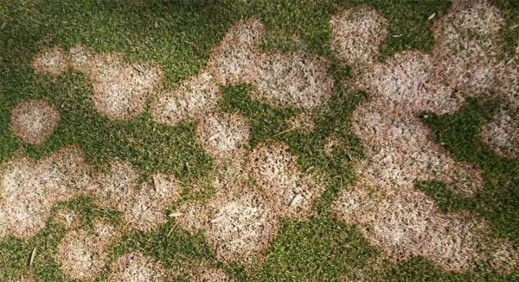
Turf diseases are typically associated with the heat and humidity of summer. Terms like Dollar Spot, Summer Patch and Pythium Blight occupy the minds of turf managers and lead to some stressful times. It comes as a surprise to many that there are disease concerns in the cold of winter as well. Snow mold is a fairly common occurrence in parts of the country, like Cedar Rapids and Iowa City, where grass sits under extended snow cover, and can even arise without snow in cold, wet conditions. There are two kinds of snow mold; pink and grey.
Pink Snow Mold

Pink snow mold arises in periods of cool, wet, overcast weather. Temperatures in the 35-55 degree range provide ideal conditions for the formation of this disease. It starts out as small, water-soaked patches of turf. These patches eventually grow in size and adapt a bleached-out appearance, with the outside of these rings having a pink color.
Grey Snow Mold

Gray snow mold forms when turf sits under snow cover for extended periods of time, especially if the ground isn’t frozen when the snow accumulates. Symptoms appear after the snow melts, in circular patches that are 1-3’ in size. The turf will have a matted-down appearance, and will have a yellow/gray color. When the disease is active, it produced small, black round structures that look like pepper has been sprinkled across the turf.
Prevention and Treatment of Snow Mold in Iowa
Since we can’t control the weather, there are things we can do to maintain the turf in a way that helps prevent this disease from forming. Pink snow mold thrives in heavy thatch, so making sure your lawn is aerated every fall will keep the thatch layer at a reasonable thickness. To go along with this, we want to prevent leaf cover over the winter as well. If complete removal isn’t possible, mowing over leaves and mulching them will help considerably. Proper mowing is essential to turf health all season, and mowing the turf about 1” shorter in the late fall is beneficial in many ways; one of those is disease prevention. Leaving the turf longer going into winter creates an environment that fosters the development of disease. Fall fertilization is a common practice to help strengthen turf and prepare it for spring. Lawns in the midwest require a special level of care. That’s why homeowners in Cedar Rapids, Iowa City and surrounding communities trust UltraLawn for their lawn care. Get a satellite quote from the comfort of home.

No comment yet, add your voice below!